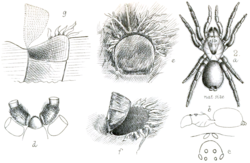| Front-eyed trapdoor spiders | |
|---|---|
 | |
| Male Idiops constructor in India | |
 | |
| Idiops crassus and its trapdoor nest entrance | |
| Scientific classification | |
| Kingdom: | Animalia |
| Phylum: | Arthropoda |
| Subphylum: | Chelicerata |
| Class: | Arachnida |
| Order: | Araneae |
| Infraorder: | Mygalomorphae |
| Family: | Idiopidae |
| Genus: | Idiops Perty, 1833 [1] |
| Type species | |
| I. fuscus Perty, 1833 | |
| Species | |
96, see text | |
| Synonyms [1] | |
| |
Idiops is a genus of armored trapdoor spiders that was first described by Josef Anton Maximilian Perty in 1833. [6] It is the type genus of the spurred trapdoor spiders, Idiopidae. Idiops is also the most species-rich genus of the family, and is found at widely separated locations in the Neotropics, Afrotropics, Indomalaya and the Middle East. [7]
Contents
Females live in tubular burrows lined with a thick layer of white silk. These typically have a D-shaped lid that fits into the entrance like a cork, and some burrows have two entrances. [8] The lid may consist of mud, moss or lichen, which is bound below by a thick layer of silk. As in all genera of this family, the anterior lateral eyes (ALE) are situated near the clypeal margin, far in front of the remaining six eyes, which are arranged in a tight group. [9] The males which are smaller in size, wander about or occasionally live in burrows. [10]
Like other mygalomorphs, they are relatively large and long-lived. Forest clearance and agricultural practices that loosen the soil and enhance erosion, besides soil removal for brick making have been pointed out as serious threats to some Indian species. [8] Species ranges are poorly known – in India for instance, most species are known only from their type localities. [7]